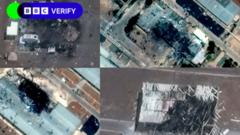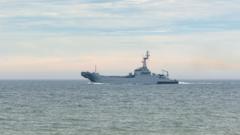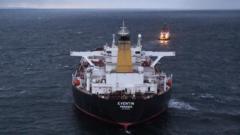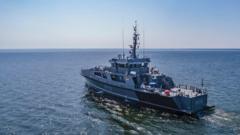The Russian warship Boikiy, accompanied by two sanctioned tankers, has been reported to have used a false identification signal during its journey through the English Channel. This action has raised alarms regarding the tactics employed to obscure sanctions violations, leading to a military escort that may heighten tensions in the region.
Russian Warship Employs Deceptive Tactics in English Channel Passage
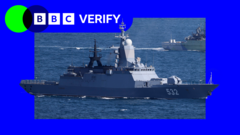
Russian Warship Employs Deceptive Tactics in English Channel Passage
A Russian corvette allegedly used a fake ID signal while traversing the English Channel, raising concerns over maritime security and sanctions evasion.
The Russian corvette Boikiy reportedly cloaked its identity by broadcasting a false ID signal while transiting the English Channel, according to a recent investigation by BBC Verify. The ship was seen sailing on Saturday alongside two sanctioned oil tankers, raising questions about its intent and the motivations behind its discreet navigation.
Utilizing a technique that misled tracking systems, the Boikiy misrepresented itself by mimicking a code previously used by other vessels. This tactic drew scrutiny, prompting analysis which confirmed the ship’s identity through satellite imagery and video evidence. The Boikiy had departed from West Africa in June, where it was engaged in a diplomatic mission, and was assessed by experts as being part of a larger Russian strategy to protect sanctioned vessels.
The investigation indicates that recent Western policies targeting Russia’s "shadow fleet"—a collection of tankers obscuring their ownership—may have influenced Moscow to deploy naval escorts to prevent potential boarding by NATO forces. Dmitry Gorenburg from the Center for Naval Analyses remarked on the military escort’s intention to deter encounters that could escalate into confrontation.
An unusual aspect of the Boikiy's actions was its decision to not activate its Automatic Identification System (AIS), which is typically mandatory for maritime vessels, although military ships often operate without it. The ship instead reportedly transmitted a generic identification number to stay off the radar while navigating.
The Boikiy's camouflaged movements were initially flagged on social media by independent analyst Christian Panton, leading to further investigation by BBC Verify, which noted that the corvette was actively monitored by the Royal Navy as it passed through British waters.
As the Boikiy approached the entrance of the English Channel, it was accompanied by the Sierra and Naxos tankers, both of which are under UK sanctions. Satellite imagery confirmed the presence of all three vessels, reiterating the Boikiy's stealth tactics as it headed toward the Baltic Sea, possibly en route to Russian ports.
The operation has sparked ongoing discussions in Western defense circles regarding the potential for heightened maritime tensions and security concerns stemming from Russia's deceptive maneuvers. The destination of the vessels remains speculative, but indications point toward passages through critical regions where sanctions are enforced.
Utilizing a technique that misled tracking systems, the Boikiy misrepresented itself by mimicking a code previously used by other vessels. This tactic drew scrutiny, prompting analysis which confirmed the ship’s identity through satellite imagery and video evidence. The Boikiy had departed from West Africa in June, where it was engaged in a diplomatic mission, and was assessed by experts as being part of a larger Russian strategy to protect sanctioned vessels.
The investigation indicates that recent Western policies targeting Russia’s "shadow fleet"—a collection of tankers obscuring their ownership—may have influenced Moscow to deploy naval escorts to prevent potential boarding by NATO forces. Dmitry Gorenburg from the Center for Naval Analyses remarked on the military escort’s intention to deter encounters that could escalate into confrontation.
An unusual aspect of the Boikiy's actions was its decision to not activate its Automatic Identification System (AIS), which is typically mandatory for maritime vessels, although military ships often operate without it. The ship instead reportedly transmitted a generic identification number to stay off the radar while navigating.
The Boikiy's camouflaged movements were initially flagged on social media by independent analyst Christian Panton, leading to further investigation by BBC Verify, which noted that the corvette was actively monitored by the Royal Navy as it passed through British waters.
As the Boikiy approached the entrance of the English Channel, it was accompanied by the Sierra and Naxos tankers, both of which are under UK sanctions. Satellite imagery confirmed the presence of all three vessels, reiterating the Boikiy's stealth tactics as it headed toward the Baltic Sea, possibly en route to Russian ports.
The operation has sparked ongoing discussions in Western defense circles regarding the potential for heightened maritime tensions and security concerns stemming from Russia's deceptive maneuvers. The destination of the vessels remains speculative, but indications point toward passages through critical regions where sanctions are enforced.




